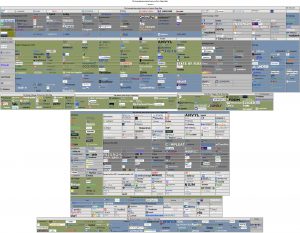While Legal is often out of sight, out of mind, Legal can be quite the thorn in Procurement’s side, especially when Procurement wants to do something that Legal doesn’t think is a good idea. Chances are Procurement has done its research, and due to extenuating circumstances (a supply line went down, an operational centre was damaged by a natural disaster, etc.) knows that the organization might not have a choice, but that doesn’t mean that Legal is going to agree, or sign off.
But that is only one example of how Legal can be an Organizational Procurement Damnation. As per our original damnation post, Legal is run by the Chief Consul who reports to the CEO, a Chief Counsel who will order his organization to do what he believes the CEO wants done, even if that’s not what anyone else wants. If the CEO says to get standard contracts in place, the Chief Consul is going to order standard contract templates for all direct materials and services. If the CEO is worried about child or slave labour in the supply chain, Legal is going to order each and every supplier vetted, immediately.
And while this insistence on onerous clauses or tunnel vision can be bad, the minute you want to obtain a “Contract” Lifecycle Management solution, a whole new level of damnation emerges. Legal is going to immediately insist that “contracts” are their domain and they need to be the owners of the contract solution. And this is very bad from a Procurement perspective because all Legal typically cares about is contract creation (drafting, authoring, and signing), contract archival, and contract retrieval and their definition of a Contract Management solution is one with strong drafting and authoring capabilities, version control, audit trails, clause repositories, Microsoft Word integration, etc. This is only a very small part of the 3-phase CLM process that starts with a need identification and ends with a proper post-mortem, and a process that depends heavily on a successful sourcing exercise (to identify the right buy) and a successful supplier management process (to insure the right products and services are obtained at the right price at the right time at the right location in sufficient quantity and of sufficient quality). While a good contract is critical, as it must accurately capture everything leading up to the creation and spell out what will happen after signing, it is a very small part of the process and the best contract in the world is useless if you can’t execute. Plus, Legal can continue to use whatever they use now to create contracts, so it’s not like lack of a strong contract authoring solution is holding them back.
So what can you do to prevent Legal from being a thorn in your side?
1. Consult them early in a strategic project or one with urgent timelines.
Let them know what is being sourced, why, what the critical requirements are, and when the contract will be needed by. Ask them for their major concerns, standard organizational requirements, and any issues they will be looking out for. Some of the requirements Legal says it will insist on might be ridiculous and might require some internal negotiation, but the last thing you want to be is blindsided during what you believe will be a cursory review and signature from Legal. Get ahead of any issues and everything will go smoother.
2. Meet with them on at least an annual, if not quarterly, basis to identify operational or emerging concerns that they would like Procurement to be on top of, and get on top of them.
If they are worried about child and slave labour, potential payments to terrorist organizations, poor environmental reputation in the supply base, Procurement can present a solution (such as a CSR monitoring platform) and get them to help Procurement get the funding it needs to monitor such issues (and reduce operational risk). Which recommendation is going to carry more weight with the C-Suite when money is involved — the CPO’s, or the Chief Counsul’s?
3. Regardless of what the vendor calls it, you want a “Sourcing Execution Lifecycle Management with Strong Contract Support” solution.
Legal will still stick their nose in, especially since they will have to use the contract module, and try to sway you towards a solution of their choice, but a properly framed request will increase Procurement’s chance of obtaining the right solution. Make it clear that Procurement needs a solution to manage the Source to Pay lifecycle effectively, to ensure that it not only negotiates good deals but realizes them, and that Procurement would like that solution to revolve around the contract. Indicate that you have identified a few vendors with the key capabilities required for Procurement to identify, negotiate, and capture great deals, each of which appears to have a strong contract module, and ask Legal what they are looking for, indicating that their requirements will be included in the evaluation of the contract module and will influence the overall weighting, designed to bring the best value to the organizational overall. Also, if each affected organization is allowed to have one stakeholder representative review the components that affect them, and those reviews are averaged with Procurements, Procurement will have an easier time getting buy-in, as it will be able to say “if all things are equal, we will get the system with the contracts module better suited to Legal”. When the need, rationale for, and expected benefits of a solution are clearly communicated, it will be easier for all parties to work together, Procurement and Legal included.

